How to Use Slack for Customer Support
Learn how to use Slack for customer support, including integration with help desks, creating dedicated channels, and automating workflows for efficient B2B support.
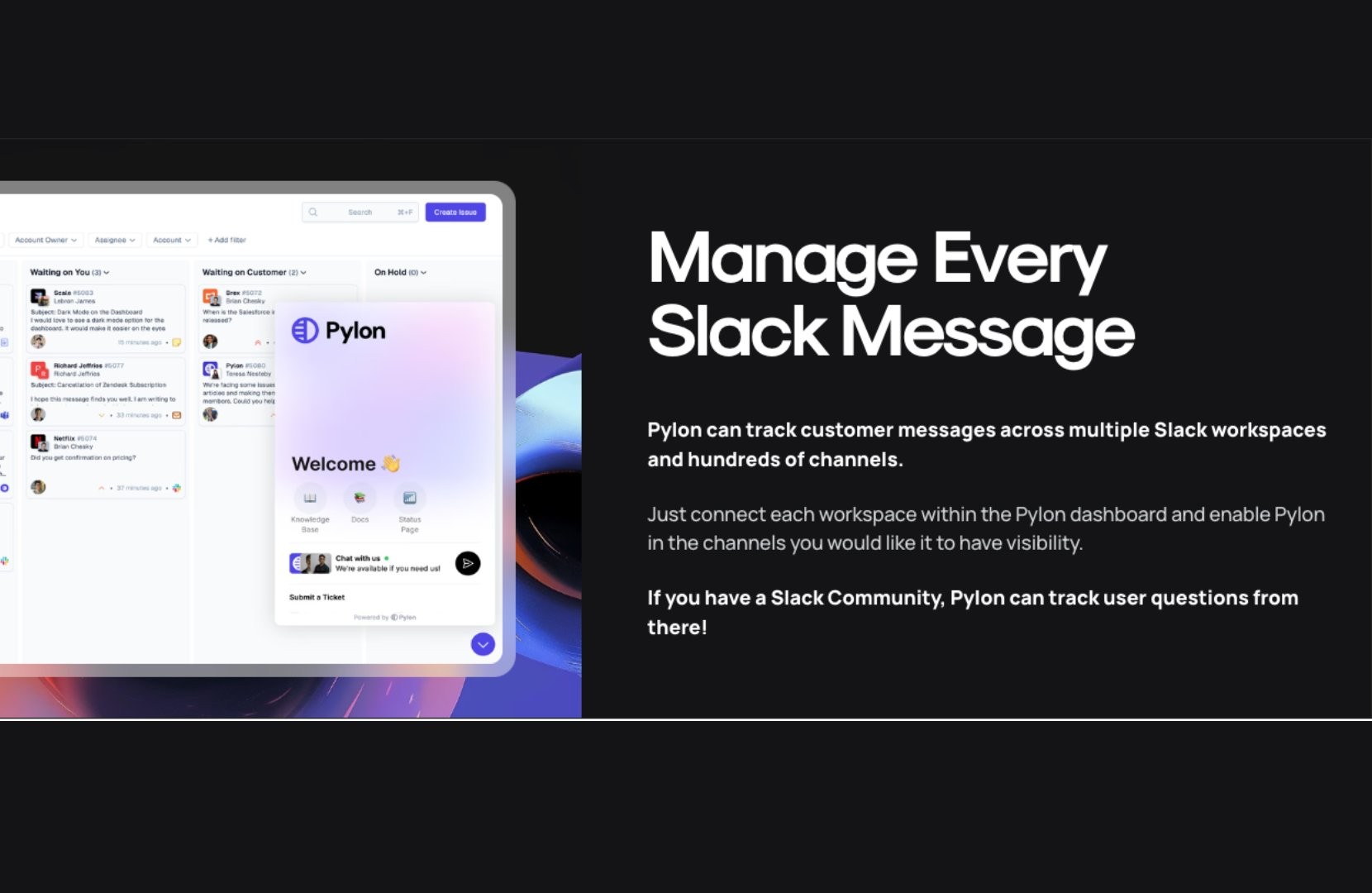
Slack has become the go-to tool for modern B2B collaboration. It embodies what today’s professionals want in a workplace: transparency, connection, and real-time communication.
According to Slack’s recent research, 91% of workers want to feel more connected to their colleagues. With 74% of professionals preferring real-time messaging at work and 70% saying Slack’s availability would influence their decision to accept a job offer, it’s clear that tools like Slack are essential.
Today’s customers want support channels that are fast, flexible, and familiar. In B2B customer support, long email threads or ticketing portals often feel too slow. With Slack, customers can get quick responses, collaborate with their team in real-time, and stay connected on the go via mobile.
So, how exactly does Slack-based support work for B2B teams? It typically involves setting up a dedicated Slack Connect channel for each client, integrating Slack with your existing help desk system, and using tools like Pylon to route and track conversations.
You’ll also want clearly defined roles, expectations, and processes to ensure nothing slips through the cracks.
Let’s go over how to support your customers over Slack.
How to Use Slack for Customer Support
Providing top-notch customer support in Slack takes more than just creating a few channels. Here’s how to build a system that scales.
1) Integrate Slack with your customer support platform
Slack is great for conversations, but it’s not a support platform on its own. To make it a viable support channel, connect it with your help desk, CRM, or ticketing system to enable conversational ticketing.

Pylon makes this seamless by integrating Slack conversations with your other support channels in a single view. Instead of manually copying messages, Pylon allows agents to convert Slack threads into tickets that you can see alongside email, chatbot, and Teams tickets. This ensures:
- No lost messages or untracked issues
- Full visibility into support history for every customer
- Centralized metrics across channels
By routing Slack messages into a unified inbox, you can manage them alongside email and web support while keeping your team in Slack.
2) Create a plan for managing support issues over Slack
Slack moves fast, so your team needs a clear strategy for handling support requests.
Key questions to answer:
- Who is responsible for responding? Assign specific agents or teams to monitor customer channels.
- What’s the expected response time? Define your SLA and make sure it’s realistic based on staffing.
- What types of issues belong in Slack? Set guidelines for what’s handled in Slack vs. what should go through formal support.
- Will you use AI in your Slack support? If so, how will you properly train it and what rules will it follow?
- Do you also use Microsoft Teams? If so, consider setting up a Slack and Teams integration.
Consider documenting internal SOPs so everyone on the support team knows how to triage and respond consistently.
3) Create systems and notifications to answer promptly
Timely responses are crucial; otherwise, customers will lose trust in the Slack channel.
To stay responsive:
- Use tools like Pylon to send alerts for unanswered messages (e.g., no response in 1 hour).
- Set up Slack workflows or third-party bots that ping agents when SLAs are at risk.
- Build automations that escalate urgent issues based on keywords or tags.
Also, consider after-hours protocols. If no one's available 24/7, set auto-responders with expected support hours and link to self-service resources.
4) Define escalation and ticketing protocol
Some issues simply can’t be resolved in Slack alone. Bugs, outages, or multi-step technical problems usually require formal tracking, engineering input, or approvals from other departments.
That’s why it’s essential to have a clear, agreed-upon escalation process. Define:
- When to escalate. For example, anytime a bug is reported, a customer is blocked from using the product, or there's a security concern.
- How to escalate. Use Pylon or your integrated tool to convert Slack threads into support tickets. Capture context (screenshots, thread links, logs) so the issue doesn’t have to be re-explained.
- Who handles escalations. Assign an engineering on-call rotation or escalation lead. Ensure support knows who to tag or notify when needed.
It’s also helpful to build visual workflows (e.g., a flowchart or playbook) that map out when and how Slack messages become tickets or incidents. This keeps Slack from becoming a black hole for unresolved problems and ensures your customers get the attention they need.
5) Create a dedicated Slack Connect channel for each customer
Slack Connect is a game-changer for B2B support. It lets you create a shared channel between your company and a customer’s Slack workspace, turning support into a collaborative, real-time experience.
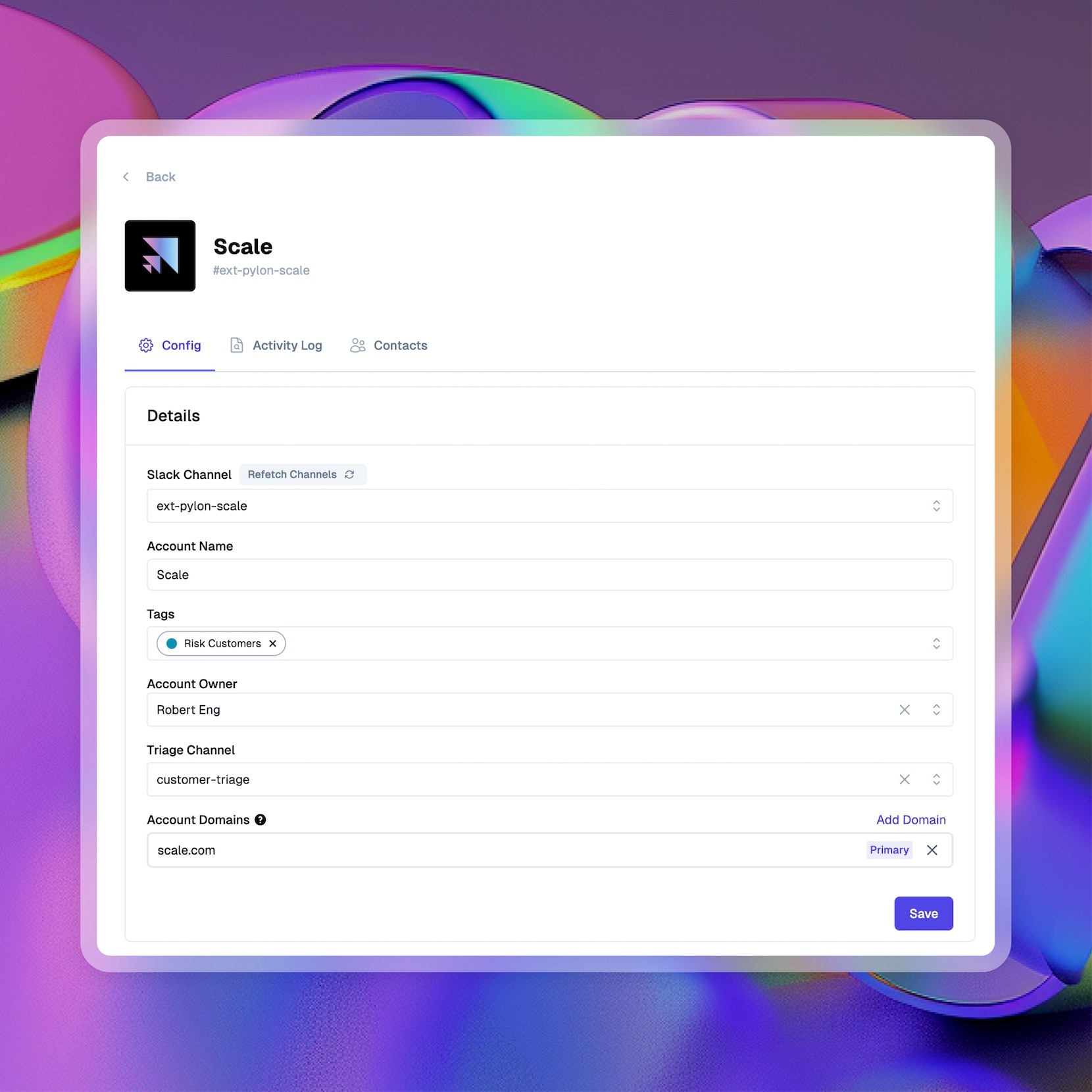
Set up a dedicated channel for each customer to:
- Keep conversations focused and private. Unlike email threads involving multiple stakeholders, Slack channels allow live collaboration with everyone involved.
- Build stronger relationships. Customers appreciate having direct access to your team and often engage more proactively in Slack than through traditional support methods.
- Tailor onboarding and support. You can pin relevant documentation, share product updates, and create a more “white glove” experience, especially for premium accounts.
Use a consistent naming convention like #support-clientname or #cust-companyxyz, and invite the relevant internal stakeholders, CSMs, support reps, and engineers based on the account’s needs.
Channels can also be grouped in Slack sections by region, tier, or product line for easier management.
6) Onboard customers to Slack
Getting customers into Slack is only the first step—you also need to teach them how to use the support channel effectively.
When onboarding a customer to Slack, include:
- A welcome message that explains the channel’s purpose
- Your support hours and expected response times
- Guidelines for communication, such as:
- Use threads to keep conversations organized.
- Share screenshots, logs, or error messages when possible.
- Avoid posting sensitive information (e.g., passwords, PII).
Here’s a sample pinned message you can customize:
🧑💻 Welcome to your support channel!
Use this space to ask questions, report issues, and contact our team.
We're available Monday–Friday, 9 a.m.–6 p.m. ET. Response time is typically under 1 hour.
Please use threads for new topics and include screenshots or error messages when reporting issues.
This kind of onboarding sets expectations early and helps avoid confusion later.
7) Monitor metrics for Slack support
Managing Slack support without data is like driving blindfolded. To improve and scale, you need visibility into how your team is performing.
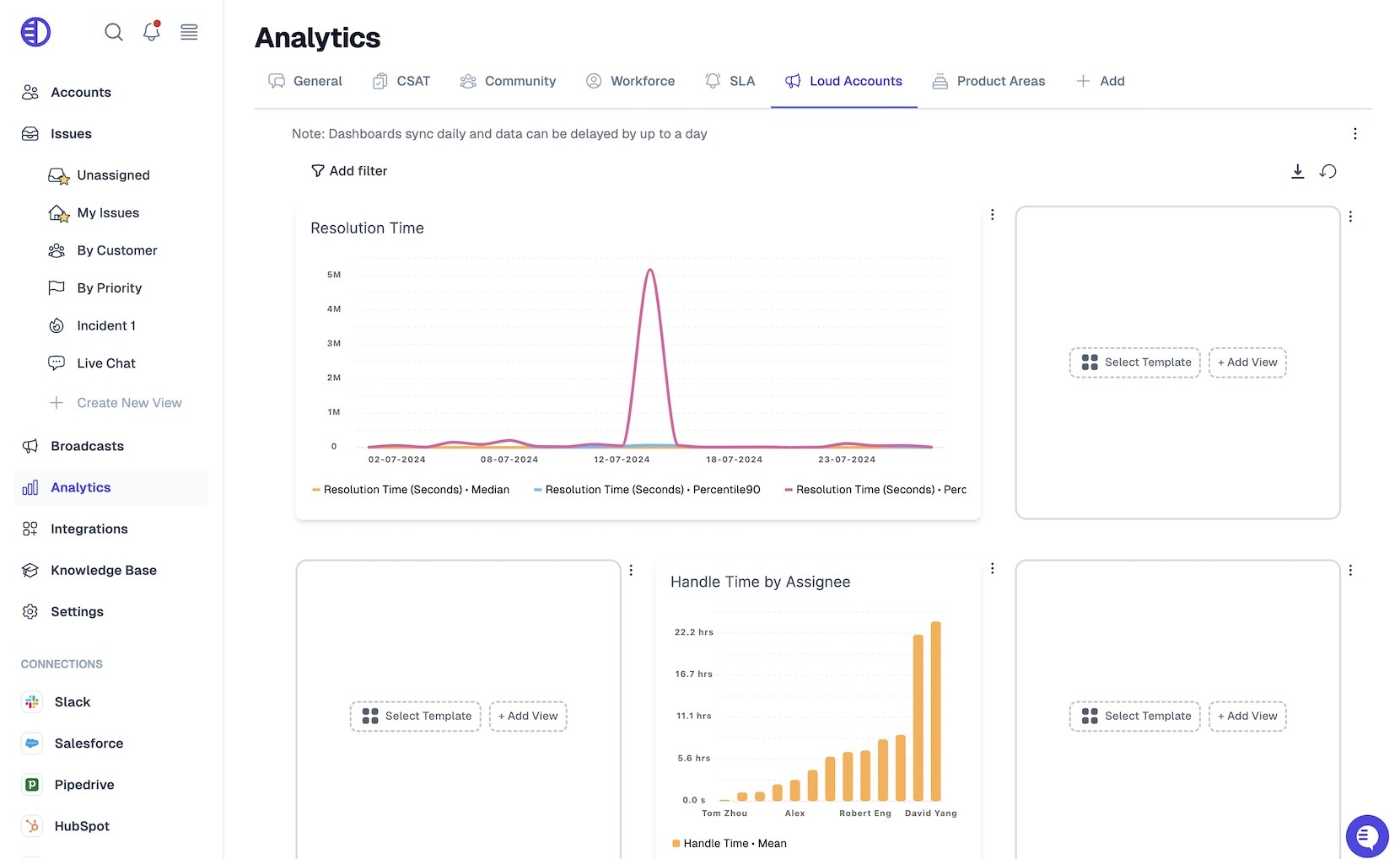
Track key metrics like:
- First response time
- Time to resolution
- Message volume by channel or customer
- SLA compliance
Tools like Pylon, Slack analytics, or your help desk’s reporting dashboard can help you visualize trends over time. For example:
- Are response times slower in the afternoon?
- Do certain customers require more support than others?
- Are escalated issues taking too long to resolve?
You can also set up alert systems to notify you when:
- A message goes unanswered for more than X minutes
- A VIP customer posts in their channel
- A high-priority issue gets tagged but not escalated
Use this data to make informed decisions about staffing, training, and process improvement.
8) Iterate over time
Slack support is never “done.” What works today might not work next quarter, especially as your customer base, product complexity, or support team grows.
That’s why it’s essential to review and refine your approach continuously.
Look for signs that your system needs an update, such as:
- Customers asking the same questions repeatedly (maybe your KB needs improvement)
- SLA breaches are becoming more frequent (you may need more staff or automation)
- Reps are unclear on when to escalate (time to revisit your SOPs)
Make iteration part of your monthly or quarterly support review cycle. Survey customers occasionally to understand their Slack support experience and solicit feedback from your team on what’s working and what’s not.
Refining your Slack support systems over time ensures you can keep up with growth, improve customer satisfaction, and deliver consistent service at scale.
Best Practices for Using Slack for Customer Support
Once you have the basics down, these best practices will help you scale your Slack support program while maintaining quality.
1) Use a platform to route Slack tickets to a unified inbox
Slack is great for visibility but terrible for long-term tracking. Routing Slack messages into a central inbox ensures:
- All issues are logged
- Conversations don’t get buried
- Your team stays accountable
Pylon does this seamlessly by syncing Slack with your other support channels in a single view.
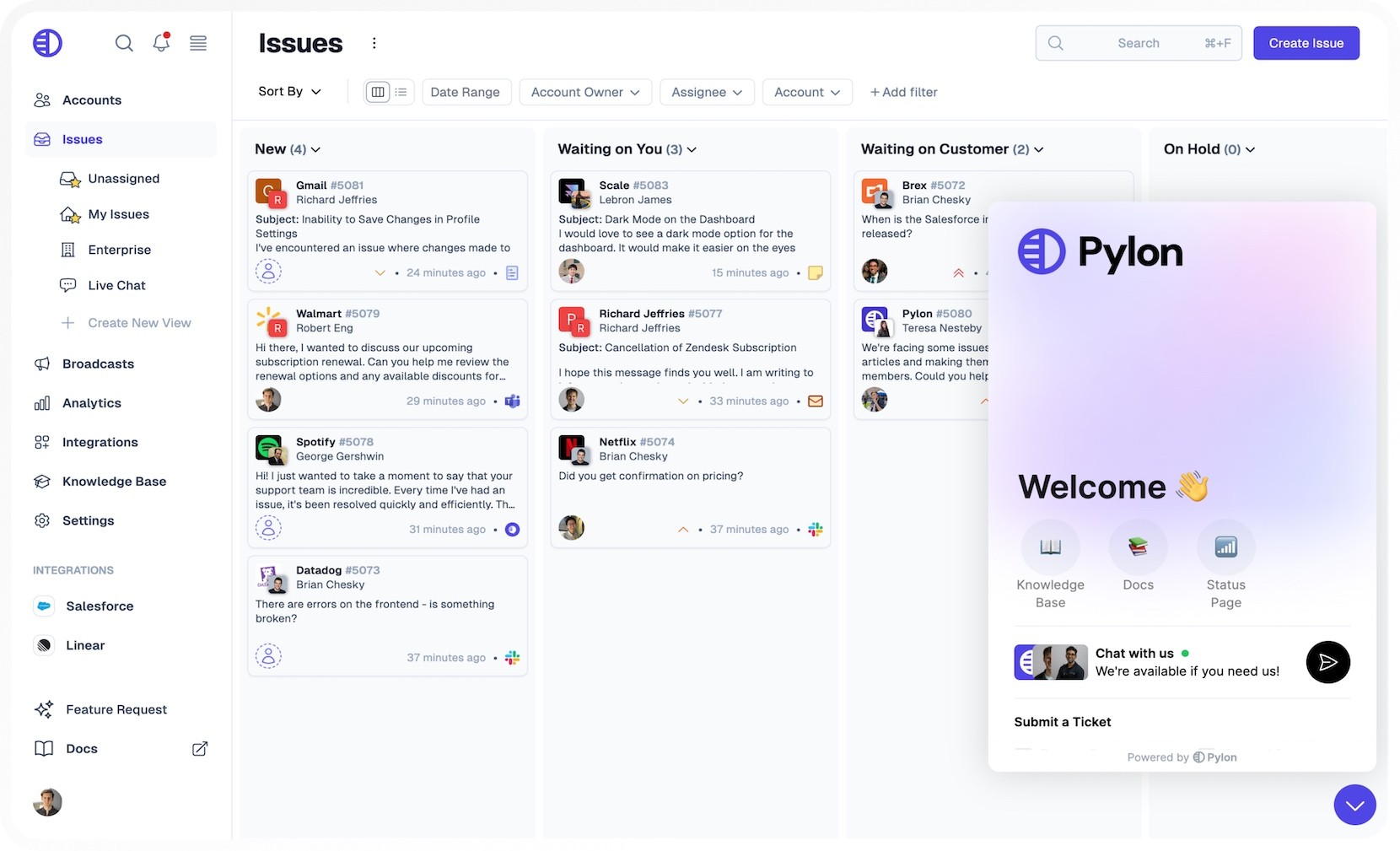
2) Integrate tools and apps you already use
Chances are, you already rely on tools like:
- Zendesk
- Intercom
- HubSpot (learn about HubSpot Slack integration here)
- Jira
- Salesforce
With Slack integrations or middleware tools like Zapier and Pylon, you can connect these platforms and automate actions like:
- Creating tickets from Slack threads
- Updating CRM fields
- Triggering workflows when specific keywords are used
This saves time and ensures your systems stay in sync.
3) Set up automated workflows
Automation can take Slack support from “chaotic” to “scalable.”
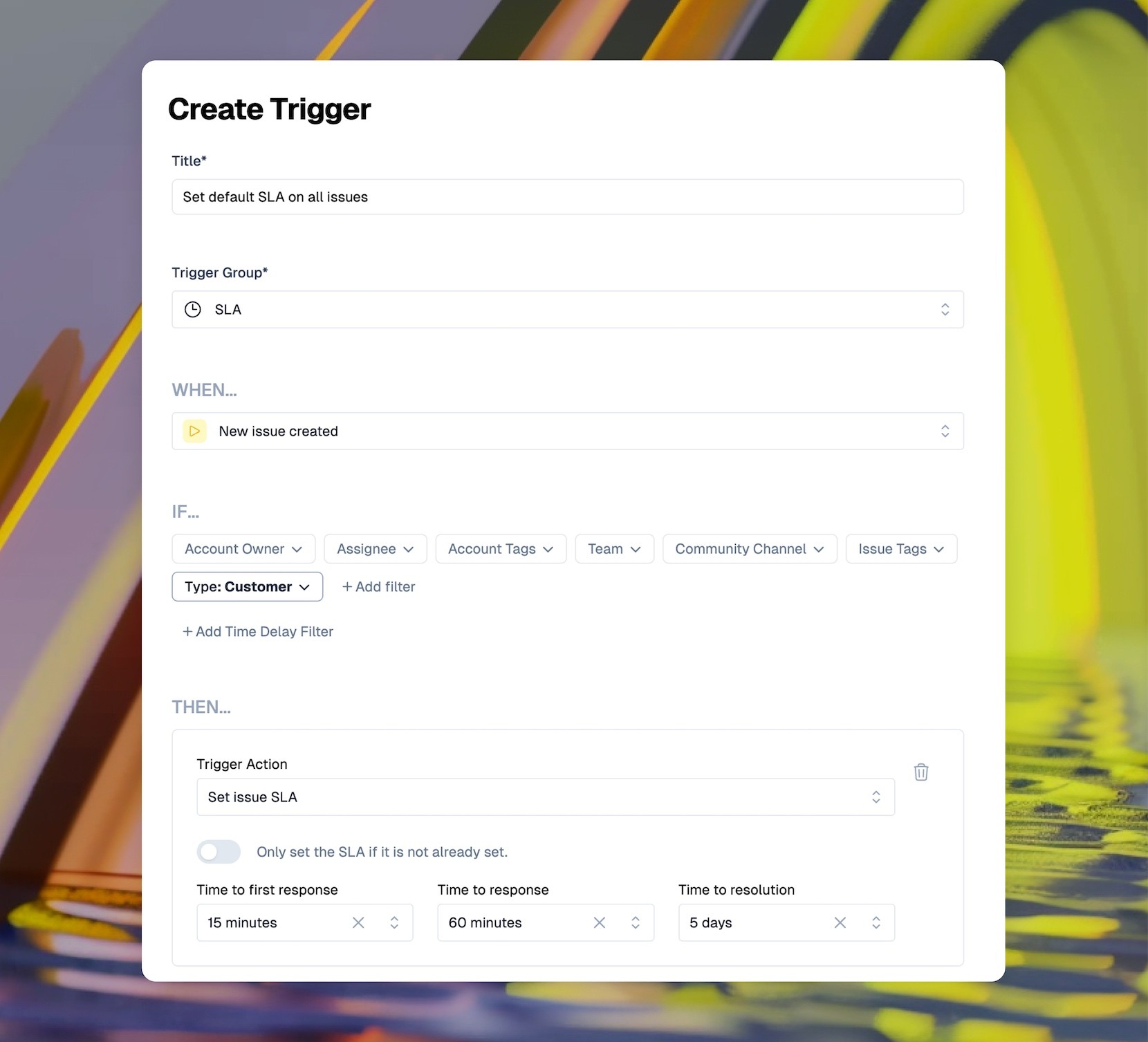
Here are a few ways to use automation:
- Automatically share help articles from your knowledge base when certain questions are asked
- Notify customers when an issue is being worked on
- Flag or escalate messages based on keywords (e.g., “urgent,” “down,” “bug”)
You can also build Slack workflows using the Slack Workflow Builder or third-party tools to reduce manual triage.
4) Set response time goals & track
Setting SLAs is especially important in B2B, where contracts often include specific timelines.
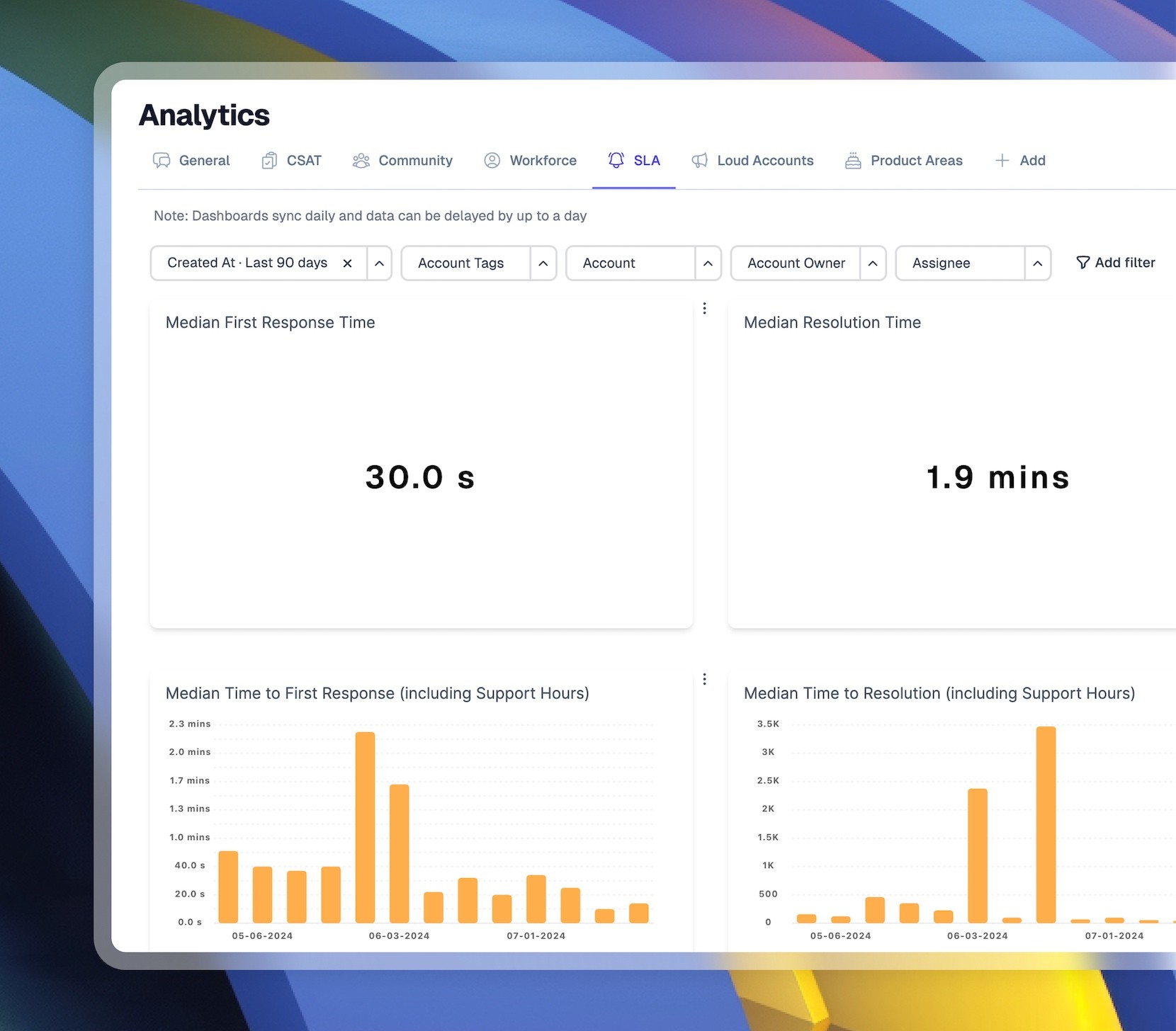
To enforce SLAs:
- Monitor first response and resolution time per customer
- Use bots to ping reps if a message goes unanswered
- Identify bottlenecks and adjust staffing or processes
If your team consistently misses goals, investigate root causes, like unclear responsibilities or a lack of after-hours coverage.
5) Come up with a channel naming convention
A consistent channel naming system keeps your Slack workspace tidy.
Some ideas:
- #support-clientname
- #customer-companyXYZ
- #cust-acme-corp
Group customer channels under one prefix (e.g., cust-) so you can easily search and filter them.
Bonus tip: Use Slack channel sections to organize customer channels by region, product line, or tier.
6) Assign channel owners
As your Slack support scales, assign an owner to each customer channel. This could be:
- A customer success manager
- A lead support agent
- An account executive (for VIP clients)
Channel owners are responsible for:
- Monitoring activity
- Looping in the right internal experts
- Ensuring timely responses
Internally, use @here or a support group tag to flag urgent messages.
7) Collaborate internally without customer visibility
Sometimes, you need to discuss a customer issue privately.
Options include:
- Using tools like Pylon to create internal notes attached to a Slack conversation
- Spinning up a parallel private Slack channel for behind-the-scenes coordination
- Using emojis or tags to flag a message internally
This keeps customer interactions professional while giving your team the space to troubleshoot.
8) Keep conversations structured with threads
Slack threads are your best friend when it comes to support.
Benefits of using threads:
- Keep related messages grouped together
- Prevent clutter in the main channel
- Make it easier to track separate issues
Encourage your team and customers to reply in threads, especially when multiple conversations happen simultaneously.
9) Channel hygiene and organization
Don’t let your Slack workspace become the Wild West.
To maintain order:
- Archive channels when customers are offboarded or projects end
- Consolidate duplicate channels to reduce confusion
- Use user groups (e.g., @support-team) to loop in relevant people quickly
Schedule regular audits to clean up unused or outdated channels.
10) Create a knowledge base & other self-service tools
Slack is a great place to surface your knowledge base documentation. You can enable self-service customer support over Slack by:
- Using bots that auto-suggest help articles based on Slack messages
- Integrating Slack with your knowledge base platform (like we offer here at Pylon)
- Setting up a custom Slackbot that answers FAQs (e.g., “How do I reset my password?”).
This lightens the load on your team and helps customers get answers faster.
Interested in setting up a knowledge base? See best practices for creating a B2B knowledge base here or how to create a SaaS knowledge base here
Security & Access Management When Supporting Customers Over Slack
Security is especially critical in B2B environments, where Slack channels often include sensitive conversations, ranging from integration details to outage reports, configuration data, or even legal and billing information.
Without strict access controls and transparent policies, your support channel can quickly become a liability.
A few careless messages or an outdated user permission can lead to a breach of trust or, worse, a data breach. That's why security and access management must be baked into your Slack support setup from day one.
Here are ways to keep your Slack support secure:
- Use SSO and identity management tools. Single sign-on (SSO) helps ensure that only authenticated users from verified domains can join your Slack workspace. Pair this with identity management platforms (like Okta, Azure AD, or Google Workspace) to control access by role, department, or region.
- Limit who can access each customer channel. Only invite internal stakeholders who actually need to be in a given channel, such as CSMs, account managers, or technical support leads. Overexposing channels increases the risk of information leaks or accidental messages.
- Remove access when a customer offboards. When a contract ends or a customer is offboarded, immediately remove them from the Slack Connect channel. Archiving the channel or revoking Slack Connect permissions ensures no lingering access to your internal ecosystem.
- Never allow the sharing of passwords or PII over Slack. Establish a zero-tolerance policy for sending sensitive credentials, payment details, or personally identifiable information (PII) in Slack. If needed, provide a secure alternative, like an encrypted file-sharing tool or password manager.
Slack also offers these enterprise-grade security features to support compliance and protect your customer data:
- Data loss prevention (DLP) integrations. Integrate Slack with your DLP provider to monitor and block sensitive data from being sent. You can define patterns (like credit card numbers or Social Security numbers) and prevent them from being posted in customer channels.
- Audit logs. Slack Enterprise Grid includes detailed audit logs that track activity across your workspace, ideal for compliance, incident response, and internal reviews.
- eDiscovery tools. Suppose you operate in a regulated industry or deal with legal requests. In that case, eDiscovery tools make it easy to export and review Slack conversations related to a particular customer, case, or incident.
- Message retention policies. Control how long messages and files are retained and whether they can be deleted. Set retention rules for specific channels, users, or types of messages to align with your company’s compliance requirements.
In addition to enabling the right security features, educate your team and customers on safe Slack usage. Always include a short security section in your Slack onboarding documentation that covers the following:
- What can and cannot be shared in the channel
- Who has access to the channel, and why
- How to report suspicious behavior or access issues
Reinforce these policies regularly, especially when onboarding new customers, launching new channels, or updating internal processes.
With strong access controls, enterprise security features, and straightforward user education, you can confidently offer customer support in Slack without putting sensitive data at risk.
Scaling Slack Support Without Losing Quality
When you have 50+ customer channels, things can get chaotic fast. What worked when you had five clients in Slack doesn’t scale when you’re juggling dozens of conversations across multiple time zones and teams.
The key to maintaining high-quality support as you scale is to build systems, assign clear roles, and lean into the right tools.
Here’s how to do it.
1) Designate a Slack coordinator to oversee support operations
As your Slack support presence grows, it’s essential to have someone who owns the process. A Slack coordinator, or even a small team, can be responsible for:
- Monitoring overall activity across all customer channels
- Ensuring proper staffing and coverage
- Reviewing workflows and handling escalations
- Managing onboarding/offboarding of customer channels
This role connects your support, success, and engineering teams, especially when customer needs span departments.
2) Use a platform like Pylon to centralize and prioritize Slack conversations
Without a centralized view, it’s easy for customer issues to get lost. While you can send emails to Slack channels, Pylon takes it a step further by consolidating messages from multiple channels into a unified inbox, where your team can:
- Sort and filter conversations by urgency or SLA
- Assign ownership to specific reps
- Create and track tickets directly from Slack
This ensures every message is acknowledged, triaged, and resolved, no matter how many channels you manage.
3) Automate as much triage as possible
Manual triage doesn’t scale. Use tools and bots to automate repetitive tasks such as:
- Tagging messages that need engineering follow-up
- Auto-routing questions to the right team based on keywords
- Notifying agents when a message goes unanswered for a set period
- Responding with help articles when common issues are mentioned
These automations reduce the burden on your team and help customers get faster responses.
4) Assign clear owners to high-volume channels
Once you hit a certain scale, it's not enough to have general team coverage. High-priority or high-traffic channels need dedicated ownership. Assign a primary point of contact (like a CSM or lead support rep) who:
- Responds to most questions
- Loops in other teams when needed
- Tracks open issues and ensures follow-up
Internally, you can reinforce ownership using tags like @channel, @here, or even a custom role like @support-clientxyz.
5) Regularly review metrics and flag risk areas
At scale, you need to be proactive. Set up dashboards that monitor:
- First response time
- Average resolution time
- SLA adherence
- Channel-specific activity volume
Look for patterns that signal issues, like increasing message volumes without increased resolution speed or channels with consistent SLA breaches. Then, update processes or staffing as needed to address them.
6) Group customer channels for better organization and support
As the number of channels grows, consider grouping them by:
- Customer tier (e.g., enterprise, mid-market, startup)
- Region or time zone
- Product line or use case
This structure helps with staffing (e.g., assigning regional reps), prioritization, and reporting. You can also set different support expectations based on tier, for instance, offering Slack access only to premium or enterprise accounts.
7) Offer Slack support as a premium feature
Not every customer needs or expects real-time Slack support. As you grow, it’s worth considering whether Slack should be:
- Reserved for top-tier accounts
- Offered as a paid add-on
- Limited to certain hours or use cases
This helps manage demand while giving high-value clients white-glove service. It also sets clear expectations around response times and availability.












